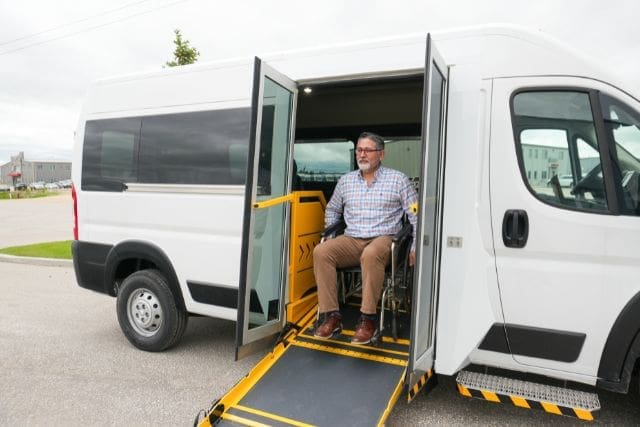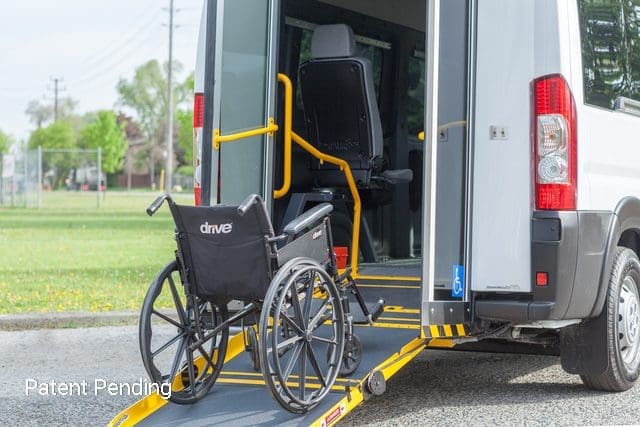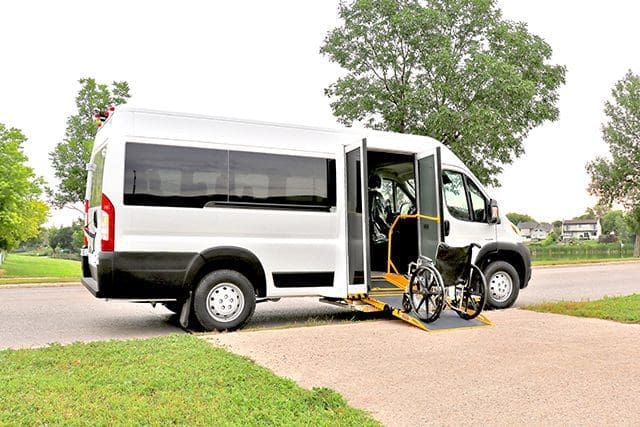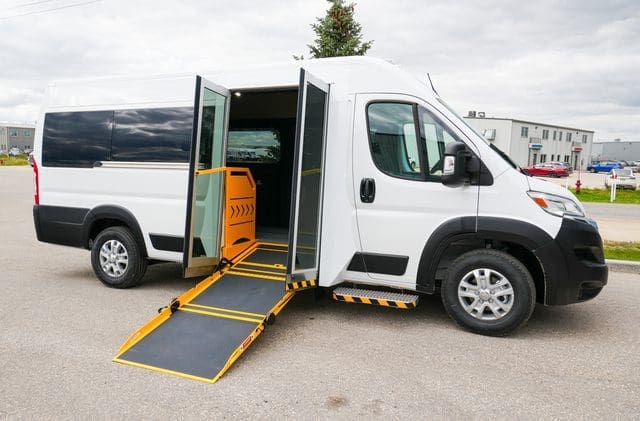Did you know that about 1 in 5 Canadians in rural areas can’t easily get around? If you’re helping run a small town in Alberta or a northern community in Ontario, you’re seeing these problems every day:
- People tell you they’re stuck at home
- Seniors can’t make doctor visits
- Workers have trouble getting to their jobs
- Teens miss after-school activities
This is annoying and is hurting your whole community. Without better options, residents might even move away.
I’m Jon, an account executive at MoveMobility. I’ve spent almost 10 years helping towns choose wheelchair vans and accessible buses. I also have a background as an emergency medical responder. I saw firsthand how poor transportation stops people from staying healthy. I’ve worked closely with communities all across Canada, finding ways to make getting around easier. But I also understand we’re just one choice among many.
In this article, I’ll show you exactly why microtransit could change things for your community, including:
- What microtransit is and how it helps smaller towns.
- Benefits that other Canadian communities already enjoy from microtransit services.
What is microtransit?
Microtransit is a smaller, more flexible type of public transportation. The easiest way I can describe it is this: it works like a mix between a van or a bus and a rideshare. Instead of running on a set route and schedule, it adjusts based on where people actually are and where they want to go.
It’s designed for towns and cities that don’t have enough people or demand to run big, traditional buses all day.
Here’s what makes microtransit different:
Smaller vehicles: Think vans or shuttles instead of full-size buses. Easier to drive, easier to park, and more fuel-efficient.
There are no fixed routes: The vehicle’s path changes depending on who books a ride and where they need to be picked up or dropped off.
On-demand service: Riders can book trips with an app, website, or a simple phone call.
Shared rides: One vehicle might pick up multiple people heading in the same direction.
If someone in your town has ever said, “I’d use public transit if it actually came to my house,” microtransit is your way to say, “Now it does.”
It’s all about giving people a smarter, more accessible way to get where they’re going, without the limitations of a traditional bus route.
What are the 5 main benefits of microtransit?
If you’re still asking yourself, “Okay, but what’s the actual upside of this?” I get it. Here are five big reasons why microtransit is catching on in Canadian communities like yours.
1. It actually reaches people
You know who doesn’t use transportation services? The folks it never comes close to. That’s a lot of people.
Microtransit changes that by meeting people where they are. Literally.
Instead of fixed stops, you get:
- Rides that come right into neighbourhoods or rural roads
- Help for people who can’t walk to a bus stop
- Access for folks who’ve been left behind by regular transit
This opens the door if your community has seniors, low-income families, or people with mobility challenges.
2. It saves a lot of money
I’ve seen towns try to run 40-foot buses with two people onboard. It’s painful.
Microtransit cuts that waste.
Here’s what you’re not paying for:
- Extra fuel for half-empty buses
- Big maintenance costs on giant vehicles
- Expensive driver certifications
You get way more value without sacrificing the quality of service. And hey, that leftover budget? You can put it toward other community programs people care about.
3. It grows with you
Communities aren’t frozen in time. A new development goes up. A senior housing project opens. A factory changes shift times. You shouldn’t have to redo your whole transit system every time that happens.
Microtransit flexes with your organization’s needs:
- You can update zones and times as needs shift
- You don’t need to reprint maps or mess with stop signage
- You can try something out without a long-term commitment
It’s like having a transit plan that can bend instead of break.
4. It makes public transit feel easy
Transit shouldn’t feel like solving a puzzle. But for a lot of people, it does.
With microtransit, there’s no guesswork. You just book a ride and go.
Why people love it:
- It works like rideshare apps they already use
- No confusing transfers or figuring out routes
- It picks you up close to home
When transit feels less like a chore, more people use it. And that’s the point, right?
5. It actually supports people’s health
I used to work in emergency medical response, so I’ve seen what happens when people can’t get the healthcare they need. It leads to missed appointments, skipped follow-ups, and minor issues turning into emergencies.
Microtransit helps fix that.
What I see communities gain:
- More people showing up to appointments
- Less stress for caregivers and family
- Better access to fitness, social events, and fresh food
Why might you want to consider microtransit?

If you’re working in local government, a health network, or even a community non-profit, you probably already know this: transportation problems show up everywhere. And when there’s no good solution in place, the stress piles up fast.
I’ve had conversations with staff from towns in Alberta and even social service teams in small BC communities. They all share similar pain points.
Here’s what they usually say:
- “We’re constantly fielding calls from people who can’t get to us.”
- “Our clinic no-shows are out of control.”
- “There’s just no affordable way to get people to where they need to be.”
Sound familiar?
Microtransit can help you fix that.
Let’s say you’re running a community health clinic, and patients keep missing appointments. A microtransit vehicle can offer rides during peak hours. Or maybe you manage a support agency and you’ve got clients living far apart with no way to reach your location. Microtransit allows you to go to them or bring them to you.
I’ve even worked with municipalities using microtransit as a bridge to bigger systems. They run on-demand services during off-peak hours or on weekends when regular buses stop running. It keeps people moving without running full-sized buses around empty.
It’s about filling the gap. Not with guesswork. With something that actually works.
Is microtransit right for your community?
So now you might be wondering, “Okay, this all sounds great, but does it actually make sense for us?” Fair question.
Microtransit isn’t a one-size-fits-all thing. But if you’ve been running into roadblocks (pun absolutely intended) with your current transit options, this could be the missing piece.
Here are a few signs microtransit might be a good fit:
You’ve got empty buses rolling around
If most of your vehicles are running with more empty seats than full ones, that’s a problem. Microtransit lets you downsize without cutting off service.
People live far apart
Fixed routes can’t cover enough ground in spread-out communities like rural Manitoba, Northern Alberta, or even parts of PEI. Microtransit fills in the gaps by going where traditional buses can’t.
You keep hearing, “There’s no way to get there”
When residents, patients, or clients tell you transportation is a barrier, believe them. If people can’t reach your services, they can’t use them. Simple as that.
You’ve got gaps in service
No buses after 6 PM? Nothing on weekends? Microtransit can plug into those quiet hours and keep your community moving when it matters most.
You want a flexible option that won’t blow the budget
You don’t need a massive fleet or a big tech rollout to get started. It can be simple. And you can grow it as you learn what works.
Still unsure? If you’re nodding along to any of these, even a little, it’s worth a deeper look.
What should you think about before starting microtransit services?

If microtransit sounds like a good fit, the next question is probably, “Where do we even start?”
The good news? You don’t need to have it all figured out on day one. But there are a few key things worth thinking through before you jump in.
Who’s going to run it?
Is it your municipality? A transit contractor? A community partner? You’ll want to know who’s in the driver’s seat, literally and figuratively.
What kind of service are you offering?
Will it be fully on-demand, or will it follow a loose schedule?
Some towns run it only during peak hours, while others use it to cover evenings and weekends. Consider when your community actually needs rides.
How will people book rides?
Technology matters, but it doesn’t have to be fancy. Some use an app. Others take bookings by phone. The right option depends on who you’re serving. If you’ve got a lot of seniors, for example, a phone line might be a better fit.
What kind of vehicle do you need?
Are you transporting one rider at a time or small groups? Do you need space for a wheelchair or stretcher? The vehicle should fit the job, not the other way around.
How will you measure success?
Ridership is one thing. But you might also look at:
- Fewer missed appointments
- Better access to community programs
- Positive feedback from riders or staff
You don’t need to solve every challenge upfront. Start small. Stay flexible. And talk to others who’ve been there.
Ready to talk about microtransit?

If your community is feeling the strain of limited transit options, you’re not alone—and you’re definitely not stuck. Microtransit could be the simple, flexible solution that actually works for your people.
I’ve worked with all kinds of organizations across Canada, and every one of them had a different starting point. You don’t need to have everything figured out. You just need to start the conversation.
Click the button below to chat with me about how microtransit might fit your community. No pressure, just a real conversation.
Let’s figure it out together.
Not ready to chat? I have a couple of other articles you might be interested in.







